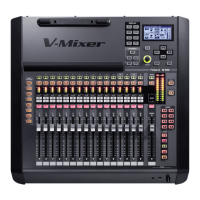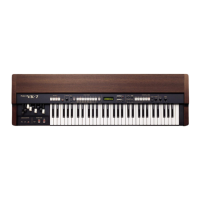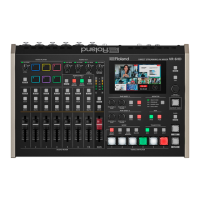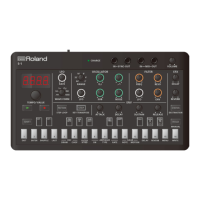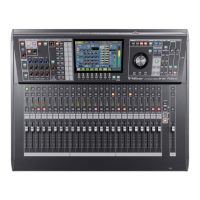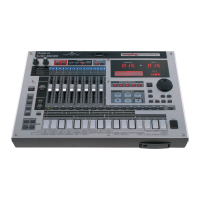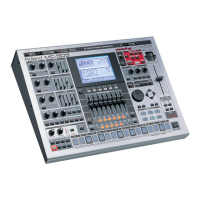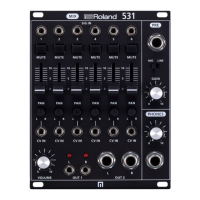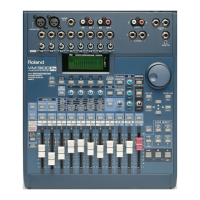
Do you have a question about the Roland V-mixing station VM-3100 and is the answer not in the manual?
| Type | Digital Mixer |
|---|---|
| Digital Effects | Yes |
| Aux Sends | 4 |
| Phantom Power | Yes |
| Bit Depth | 24-bit |
| Digital I/O | ADAT, S/PDIF |
| Effects | Reverb, Delay, Chorus, Flanger |
| EQ | 3-band EQ |
| Sampling Rate | 44.1kHz, 48kHz |
Instructions for proper grounding to prevent electrical shock and ensure safety.
Warning about the necessity of earthing the apparatus with a three-wire grounding type plug.
General warnings and cautions for safe operation and maintenance of the unit.
Key practices to ensure safe and proper use of the equipment.
Notes regarding the unit's power supply and connections.
Guidance on proper placement, environmental considerations, and cleaning.
Extra precautions to take during operation and handling of the unit.
Guidance on how to use the manual and important sections to read.
Information about the manual's scope and applicability to different models.
Compilation of reference materials including mixing tips, specifications, troubleshooting, and index.
Includes block diagrams, MIDI implementation charts, and technical specifications.
Features of the VM-3100's digital inputs/outputs for superior audio quality.
Overview of the unit's diverse functions for mix creation.
Identifies and labels all controls and connectors on the front and rear panels.
Explains the functions of XLR, 1/4" inputs, output jacks, GAIN knobs, and AUX SENDs.
Describes operation of faders, SOLO/MUTE, screen display, and level meter button.
Explains controls for compressor, EZ routing, value knobs, and bus assignment.
Covers EQ, monitor, pan, aux controls, and navigation buttons.
Details AC power, switch, digital I/O, foot switch, and MIDI connectors.
Instructions for connecting the VM-3100 to various audio devices.
Clarification of the functions of MASTER OUT and MONITOR OUT.
Steps to connect speakers and headphones and play audio.
Guidance on adjusting faders and levels to achieve desired sound.
Further steps for adjusting sound parameters like PAN and EQ.
Troubleshooting steps for when no sound is produced.
Final adjustments for sound parameters like PAN and EQ.
Troubleshooting steps for when no sound is produced.
Steps to connect microphones and CD players for mixing.
Instructions for setting channel fader levels.
Instructions for adjusting the master fader.
Steps to adjust the microphone volume using faders and knobs.
Steps to adjust the CD player's volume using faders.
Steps to prepare a channel for effect application.
How to select and apply effects like reverb.
Adjusting the output level of the applied effect.
Instructions for saving current mixer settings as a scene.
Steps to recall previously saved mixer configurations.
Guide for recording audio into DAT or MD recorders.
Instructions for using the DS-90 digital monitors for playback.
Instructions for using the DS-90 digital monitors for playback.
Exploring the effects of Speaker Modeling on different speakers.
Tips for effectively using SCENE MEMORY for various applications.
Instructions for saving current mixer settings as a scene.
Steps to recall previously saved mixer configurations.
Steps to recall previously saved mixer configurations.
How to delete saved scene memories.
How to modify existing scene memory settings.
How to navigate and select different banks of saved scenes.
Steps to connect instruments and adjust levels for demo tapes.
Adjusting the keyboard signal level.
Adjusting effects, pan, and equalizer settings for desired sound.
Adjusting the guitar signal level.
Mixing sounds from a MiniDisk as a background track.
Adjusting the microphone signal level.
Adjusting the microphone signal level.
Applying compression to the microphone signal.
Adjusting overall balance of keyboard, guitar, and vocal levels.
Configuring AUX SEND for bus routing.
Assigning mixer channels to multitrack recorder tracks.
Adjusting recording levels for instruments and microphones.
Instructions for saving current mixer settings as a scene.
Recalling saved scene settings for the first song.
Starting the recording process on the deck.
Initiating playback and performance.
Stopping the recording process.
How to undo or cancel a recalled scene memory.
Recalling saved scene settings using a MIDI keyboard.
Connecting multiple keyboards to the VM-3100.
Setting up the master keyboard for MIDI communication.
Configuring the VM-3100 to receive MIDI messages from the master keyboard.
Verifying the system setup and MIDI communication.
Using a footswitch to control scene memory changes.
Managing microphone signals for live performances.
Connecting microphones for live performances.
Adjusting the emcee's microphone level and settings.
Adjusting chorus mics and accompaniment tape levels.
Adjusting the vocalist's microphone level and settings.
Using the VM-3100 for Public Address system applications.
Controlling the VM-3100 remotely using a computer and sequencer.
Connecting a computer and MIDI module for remote control.
Configuring sequencer settings for VM-3100 control.
Setting the MIDI channel for receiving control messages.
Recording program change messages for scene control.
Controlling the MIDI sequencer using the VM-3100.
Connecting a computer and MIDI module for controlling the sequencer.
Verifying sequencer functions for MIDI control.
Configuring the VM-3100 to send MIDI messages.
Verifying sequencer functions for MIDI control.
Setting the MIDI control channel for sequencer operations.
Using a computer to control the Auto Fader function.
Connecting a computer and MIDI module for auto fader control.
Setting up the sequencer for recording MIDI fader movements.
Recording fader movements from the VM-3100 to the sequencer.
Playing back the recorded fader movements.
Guides on routing signals to BUS OUT and AUX SEND, and adjusting output levels.
Instructions for adjusting equalizer settings, EZ routing, and routing effects.
Configuration of input parameters, phantom power, and level meter displays.
Adjusting effect parameters and compressor settings for optimal sound.
Comprehensive guide to saving, recalling, and managing scene memories and solo mode.
Adjusting channel volumes, mute, monitor, and MIDI settings.
Controlling MIDI sequencers and overview of system functions and display adjustment.
Controlling MIDI sequencers/recorders remotely and system settings.
Setting clock, RMDB II configuration, and digital recorder operations.
Lists and describes various screen displays including meter, EQ, system, and channel views.
Lists and describes screen displays for effects, compressor, output, and scene memory.
Continues listing and describing system, output, and scene memory screen displays.
Continues listing and describing system, output, and scene memory screen displays.
Illustrates digital recorder connections and linking VM-3100 units.
Covers settings, precautions for VM-3100Pro connections, and operational limitations.
Lists error messages for operational commands, routing, and effect switching.
Lists error messages for clock, scene memory, bulk data, and MIDI operations.
Addresses problems like no sound, channel issues, headphone problems, and digital input.
Solves issues with noise, distortion, and MIDI device connectivity.
Details MIDI functions for channels, modes, note numbers, pitch bend, and control changes.
Covers MIDI program change, system common, system real-time, and auxiliary messages.
Visual representation of the VM-3100Pro's internal signal path.
Continues the visual representation of the VM-3100Pro's internal signal path.
Details on channels, memory, signal processing, sample rate, frequency response, and distortion.
Covers input/output levels, impedance, and connector types.
Details on load impedance, noise, display, power, weight, and accessories.
Alphabetical listing of controls and functions like AC IN, Faders, MIDI, Scene Memory, and Bus Assign.
Alphabetical listing of settings like Level Meter, MIDI, Sequencer, and System functions.
Alphabetical listing of controls like Transport, Value, and XLR Connectors.

